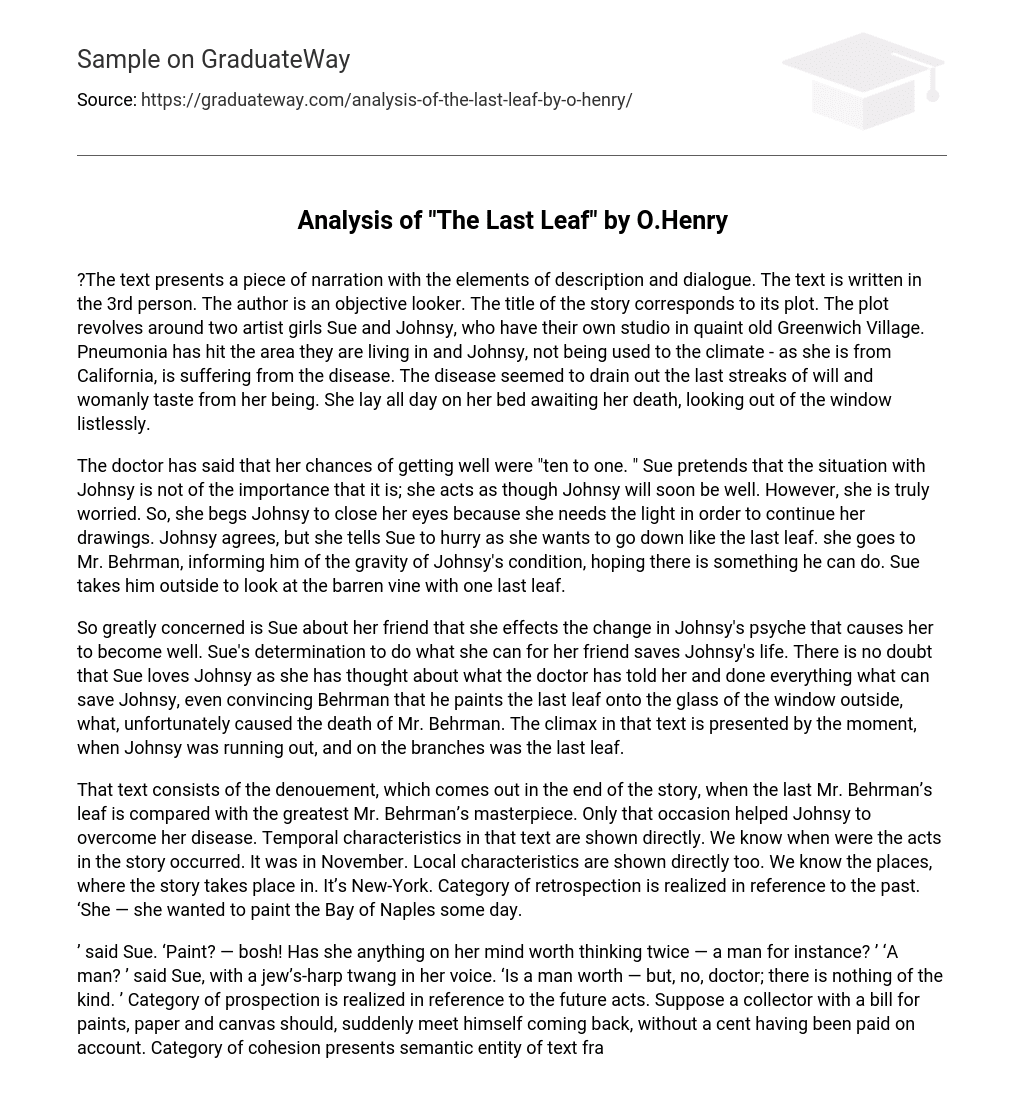The text presents a piece of narration with the elements of description and dialogue. The text is written in the 3rd person. The author is an objective looker. The title of the story corresponds to its plot.
The plot revolves around two artist girls Sue and Johnsy, who have their own studio in quaint old Greenwich Village. Pneumonia has hit the area they are living in and Johnsy, not being used to the climate – as she is from California, is suffering from the disease. The disease seemed to drain out the last streaks of will and womanly taste from her being. She lay all day on her bed awaiting her death, looking out of the window listlessly.
The doctor has said that her chances of getting well were “ten to one. ” Sue pretends that the situation with Johnsy is not of the importance that it is; she acts as though Johnsy will soon be well. However, she is truly worried. So, she begs Johnsy to close her eyes because she needs the light in order to continue her drawings. Johnsy agrees, but she tells Sue to hurry as she wants to go down like the last leaf. she goes to Mr. Behrman, informing him of the gravity of Johnsy’s condition, hoping there is something he can do. Sue takes him outside to look at the barren vine with one last leaf.
So greatly concerned is Sue about her friend that she effects the change in Johnsy’s psyche that causes her to become well. Sue’s determination to do what she can for her friend saves Johnsy’s life. There is no doubt that Sue loves Johnsy as she has thought about what the doctor has told her and done everything what can save Johnsy, even convincing Behrman that he paints the last leaf onto the glass of the window outside, what, unfortunately caused the death of Mr. Behrman. The climax in that text is presented by the moment, when Johnsy was running out, and on the branches was the last leaf.
That text consists of the denouement, which comes out in the end of the story, when the last Mr. Behrman’s leaf is compared with the greatest Mr. Behrman’s masterpiece. Only that occasion helped Johnsy to overcome her disease. Temporal characteristics in that text are shown directly. We know when were the acts in the story occurred.
It was in November. Local characteristics are shown directly too. We know the places, where the story takes place in. It’s New-York. Category of retrospection is realized in reference to the past. ‘She — she wanted to paint the Bay of Naples some day. ’ said Sue. ‘Paint? — bosh! Has she anything on her mind worth thinking twice — a man for instance? ’ ‘A man? ’ said Sue, with a jew’s-harp twang in her voice. ‘Is a man worth — but, no, doctor; there is nothing of the kind. ’ Category of prospection is realized in reference to the future acts. Suppose a collector with a bill for paints, paper and canvas should, suddenly meet himself coming back, without a cent having been paid on account. Category of cohesion presents semantic entity of text fragments achieved by description of events and characters in their logical succession.
The main it’s elements are Johnsy and the leaf. Cataphorical elements that bring the action or characters to the future. I will do all that science, if you will get her to ask one question. This text is rich in use of stylistic devises. They all are used to embellish the result of author’s minds. For example the use of metaphor- What they have was a relationship fostered on mutual trust and their common taste in art, chicory salad bishop sleeves. Using personification of pneumonia, the author shows us how strongly it might hurt the human, how horrible it may be, how many lives it can take away.
In November a cold, unseen stranger, whom the doctors called Pneumonia, stalked about the colony, touching one here and there with his icy fingers. Over on the east side this ravager strode boldly, smiting his victims by scores, but his feet trod slowly through the maze of the narrow and moss-grown ‘places. Mr. Pneumonia was not what you would call a chivalric old gentleman. Also we are able to notice the use of oxymoron- A mite of a little woman with blood thinned by California zephyrs was hardly fair game for the red-fisted, short-breathed old duffer.
The great amount of stylistic devises used in the text compels us to be impressed by both the author and the story. Reading such story the reader can accept the main idea easier, he is able to understand what the author meant.
The last leaf is a short story which entails the treasure of life and the existence of faith and hope and also how we deal with hindrance as we battled through our life. It is a story which also gives us a hint that not only God is the one and only deciding authority who draws the judgement, but the power of art is able too to affect as strong as human believe in himself, that it is true.





